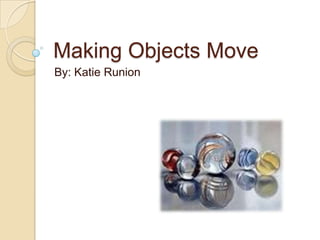
Making Objects Move Final
- 1. Making Objects Move By: Katie Runion
- 2. Indicator 3.2.5 Construct something used for performing a task out of paper, cardboard, wood, plastic, metal, or existing objects. Lesson Plan Website: http://www.sciencenetlinks.com/lessons.php?DocID=35
- 3. Definitions Motion- any physical movement or change in position or place. Track- A path along which something moves. Construct- To form by assembling or combining parts; build.
- 4. Background Information There are many different things that can be built using paper, cardboard, wood, plastic, metal, or existing objects. Scientists build their inventions out of these materials.
- 5. Before the activity, answer these questions beside the PowerPoint What are all the ways to move a bouncy ball from one place to another? Is there a way for the bouncy ball to move in a straight line on its own? How could the bouncy ball move on its own?
- 6. Activity Take out all the supplies from your box. Your task is to build a structure for the bouncy ball to roll down. When building your track, you must follow all the requirements on the next slide.
- 7. Requirements You can only use tape and toilet paper rolls when building your track. Your bouncy ball must roll all the way down the track on its own. Your bouncy ball cannot roll any further than 1 yard past the end of your track. You have 30 minutes to complete this task.
- 8. Answer these questions beside the PowerPoint Did you have to change the track to make the ball go a shorter distance? If so, how? Did you have to change the track to make the ball go a longer distance? If so, how?
- 9. Do this on a separate sheet of paper Draw a picture of the structure you built. Under the drawing, explain what it does and how it works.
- 10. Assessment What building material did you use to construct your track? A.) Metal B.) Cardboard C.) Plastic D.) Lego's What was your assignment in this PowerPoint? A.) to write an essay B.) to paint a track C.) to color D.) to construct a track